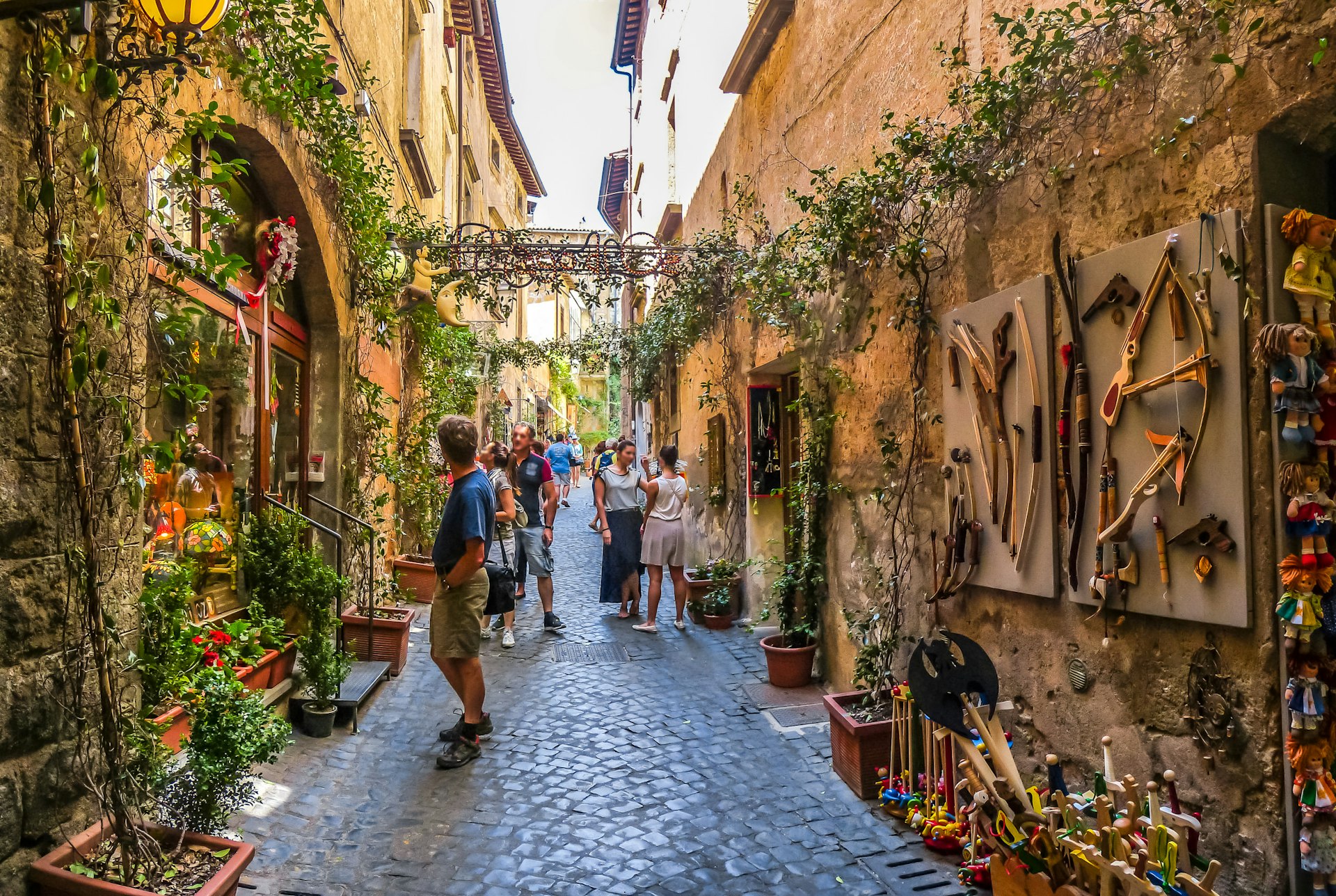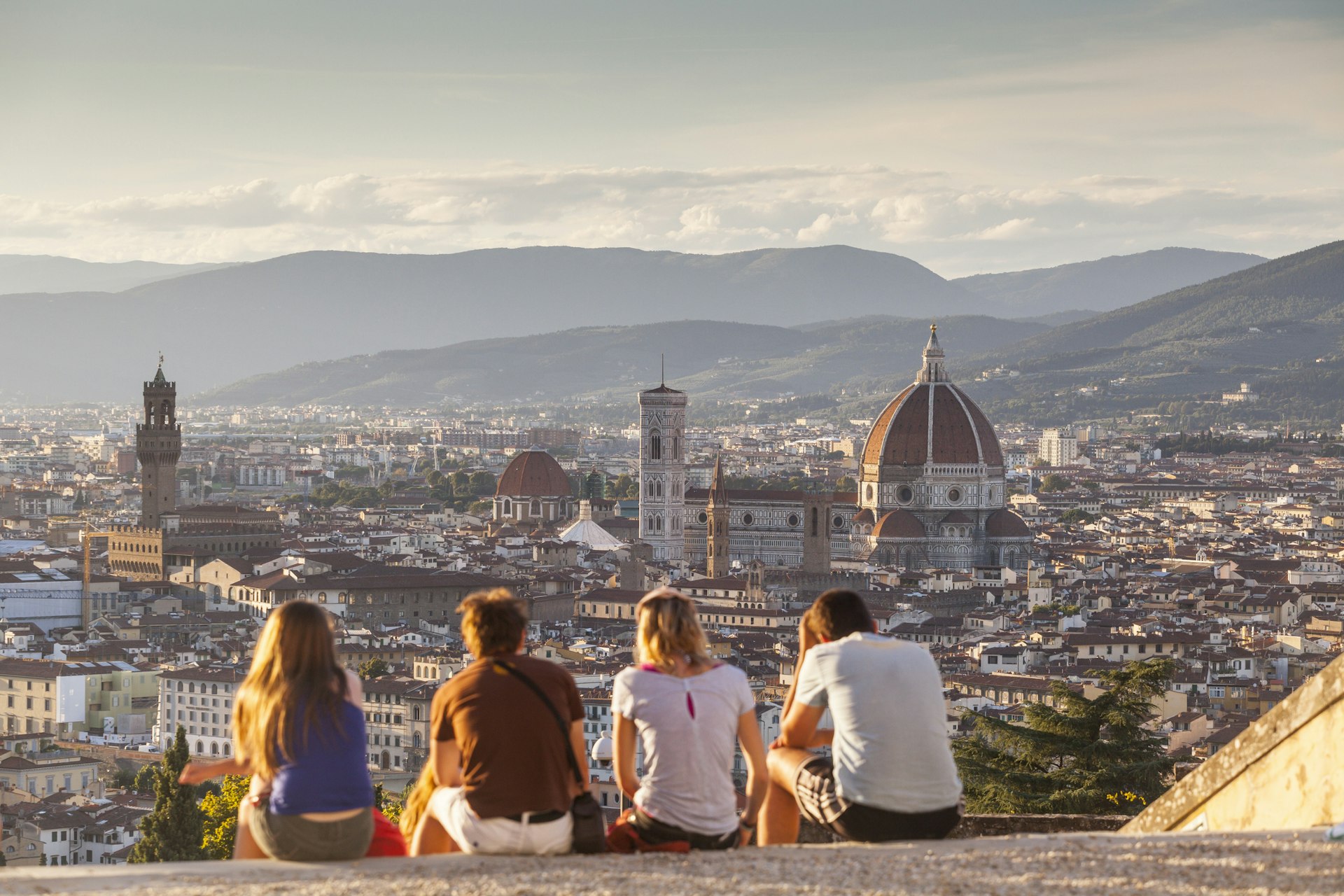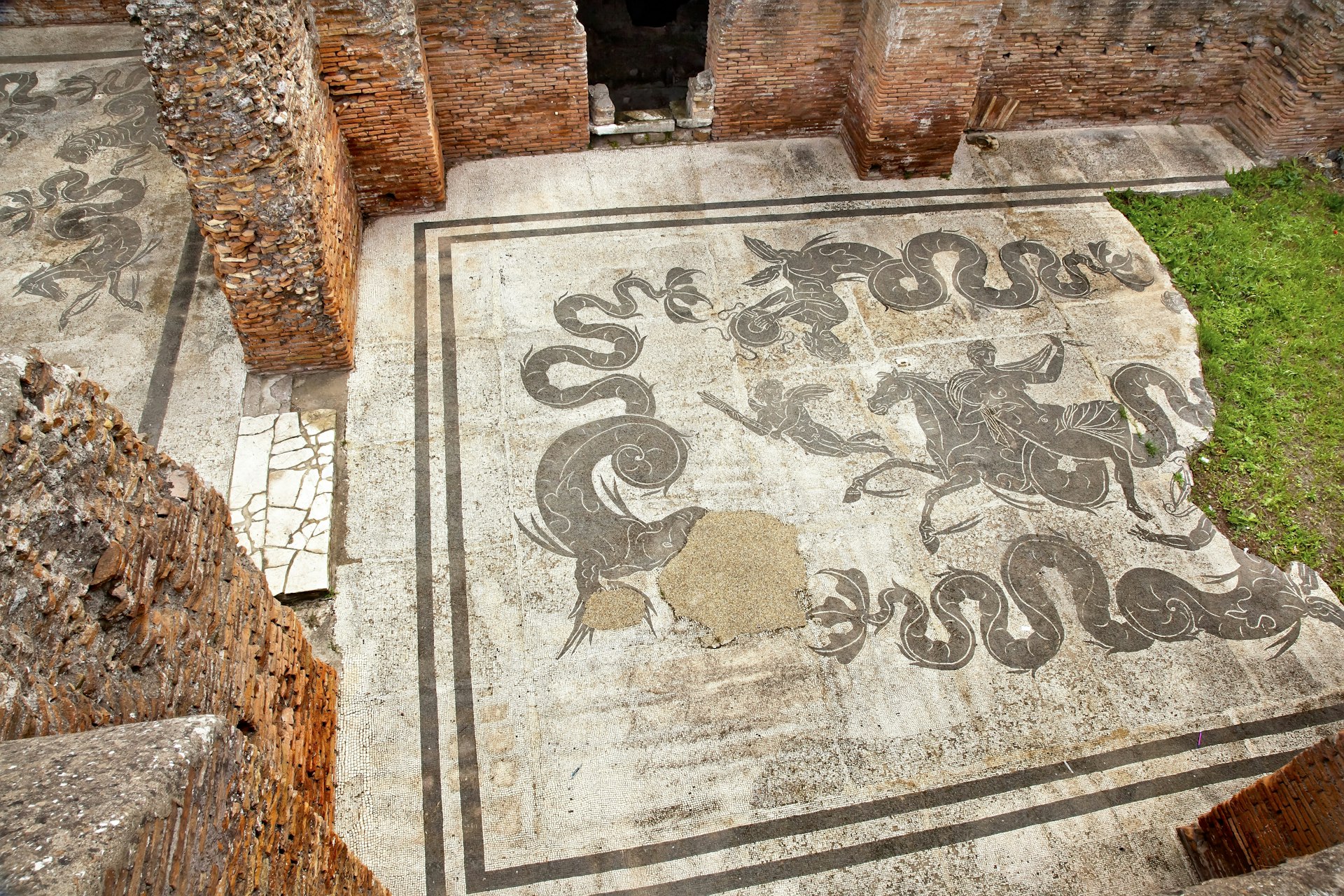With so much to see in Rome, you’d be forgiven for never making it outside the city limits, but the wealth of attractions doesn’t end with the Colosseum or the Vatican. If you choose to explore the region of Lazio, of which Rome is the capital, you’ll be richly rewarded.
Between sprawling historic sites, outdoor attractions for all seasons, and not-so-secret food and wine destinations, the area surrounding Rome might be just as fascinating as the city itself. Farther afield, Florence, Naples and Pompeii are all close enough to plan a day trip from Rome: they don’t call it the center of the world for nothing.
Here are the very best places near Rome to visit on a day trip – and how to get there.
1. Explore the ancient ruins at Ostia Antica
Travel time: 30 mins
One of the easiest outings from Rome is a day trip to the Scavi Archeologici di Ostia Antica, the remarkably well-preserved ruins of ancient Rome’s sea port. Don’t miss the Terme di Nettuno, a 2nd century baths complex with striking floor mosaics and a steeply stacked amphitheater in the heart of the ruins (used until the 4th century AD). You can also see the Thermopolium, an ancient cafe where you can make out traces of a menu frescoed on the wall. If the daily specials of a few millennia past don’t strike your fancy, Ristorante Monumento serves filling pastas and local seafood near the site’s main entrance.
How to get to Ostia Antica from Rome: Take the Ostia Lido train from Stazione San Paolo in Rome (next to Piramide metro station) and get off at Ostia Antica.
2. Visit an Etruscan City of the Dead in Cerveteri
Travel time: 55 mins
The pre-Roman Etruscans left an indelible mark on the civilizations that followed, but much of their culture remains shrouded in mystery. However, one of the best preserved Etruscan ruins is just outside of Rome at the Necropoli di Banditaccia in Cerveteri. A Unesco World Heritage listed site this haunting necropolis, just outside the modern town, is a veritable city of the dead, with streets, squares and terraces of circular grass-topped tombs known as tumuli.
Once you’ve explored these, complete your Etruscan education at the Museo Nazionale Cerite back in the historic center. Nearby, Da Bibbo is a cut above your average osteria.
How to get to Cerveteri from Rome: Regular Cotral buses serve Cerveteri from Cornelia metro station. By car, the town is 28 miles (45km) north of Rome, off the A12 autostrada. The necropolis is a mile from the city center.
3. Make it a day at Pompeii
Travel time: 2.5 hours
If you’re a history lover, head south to the of Pompeii Archaeological Park at the foot of Mount Vesuvius, just south of Naples. Although you could spend a lifetime studying the remains of the city frozen in time, you can also see quite a bit of it in a day. Visit the Lupanare, the only remaining ancient Roman brothel, and the Stabian baths, for a window into daily life in Pompeii. There are also beautifully preserved private residences like the Villa dei Misteri, whose painted walls depict Dionysian rituals. Speaking of which, archaeologists have just discovered a second fresco in Pompeii featuring mensa flatbread, a precursor to pizza. Pompeii residents clearly took their snacks seriously!
How to get to Pompeii from Rome: There are frequent high speed trains that leave Termini station for Naples. From there take the Circumvesuviana train to the stop at Pompeii. Rumor has it that the high speed train will link up directly to Pompeii in 2024, which would significantly reduce the journey, so if you’re planning for next year keep an eye out for updates.

4. Visit two World Heritage sites in one day at Tivoli
Travel time: 50 mins
For a tiny town, Tivoli has a lot to offer visitors looking for something a little different. Located a little over 15 miles east of Rome, it is an easy trip from the center to Villa d’Este, a Renaissance residence high up in the hills. Once you’ve admired the florid Mannerist frescoes and extravagant garden fountains, treat yourself to something special at Ristorante Sibilla. Next take a post-lunch walk down to Villa Adriana, the country estate that once belonged to Roman Emperor Hadrian. The spectacular grounds are filled with towering ruins that languish beneath gnarled olive trees and enormous umbrella pines.
How to get to Tivoli from Rome: Tivoli is accessible by regular Cotral bus from Ponte Mammolo metro station and takes about 50 minutes. Another option is a train from Stazione Termini to Tivoli, which departs every 15 minutes. To get to Villa Adriana from Tivoli’s historic center, take local CAT bus number 4 or 4X from Largo Garibaldi.
5. Soak in thermal baths and meet monsters in Tuscia
Travel time: 1.5 to 2 hours
Head due north of Rome to explore some of the best kept secrets in Italy, which most people miss as they duck in and out of the capital. Start your day exploring the Parco dei Mostri in Bomarzo, a 16th century sculpture garden populated by evocative structures that the first owner of the property commissioned to cope with the grief of losing his wife.
Known as Tuscia, the northern Lazio area that borders Umbria and Tuscany is a great place to soak in thermal waters that flow naturally from the volcanic soil underneath. The Terme dei Papi was used as a private bath for the popes who briefly resided in Viterbo in the middle ages, and its now a popular year round site for health lovers. Once you’ve had a soak, take a stroll through the medieval San Pellegrino quarter of Viterbo and stop for a cocktail at the Magnamagna in Piazza della Morte.
How to get to Tuscia from Rome: Viterbo is connected to Rome via train at Termini or Ostiense stations, and to access the Parco dei Mostri, get off at the Attigliano-Bomarzo station on the same line. If you’re driving, the A1 motorway is well connected to Viterbo and Bomarzo, or take the more scenic Cassia for a quieter ride.
6. Take a hike in Monti Simbruini
Travel time: 1 hour
If the seven hills of Rome don’t provide you with the adrenaline rush you’re looking for, head east to one of Italy’s finest national parks at Monti Simbruini. Close to Rome and accessible by public transport or car, Monti Simbruini has hundreds of kilometers of bike trails, walking itineraries, and historical landmarks. Though it covers almost 30,000 hectares, the park is easy to navigate and is studded with small towns that you can use as reference points or stops along the way. Admire rare species of flora and fauna, and stop for a picnic in front of geological wonders like the Karst formations in Piano di Camposecco or Mola Vecchia.
How to get to Monti Simbruini from Rome: The trip to Subiaco, one of the larger towns in the park, takes about an hour by car from the center of Rome and from there, visitors can explore the park at their leisure. All the towns of the Park are connected to Rome via local Cotral buses. Consult the map on the Park’s website to plan your trip.
7. Check out the Boho Borgo of Calcata
Travel time: 1 hour
There are no shortage of beautiful, crumbling hill towns in Italy; there are, however, very few that can claim to have been saved by hippies. Located just outside of greater Rome, the historic center of Calcata was condemned by the local government in the 1930s for fear that it would collapse. This prompted a mass exodus of residents and left the center abandoned until artists began to squat in the town in the 1960’s. Over time the squatters purchased the homes, the government rescinded the order, and the residents began restoring the ancient buildings. Now its a tiny but vibrant community with cafes, art galleries, and enough stories to fill up a day. Soak it all up at the Latteria del Gatto Nero, a restaurant and cafe that’s been in operation since the early days of the hippie resettlement.
How to get to Calcata from Rome: Calcata is an easy drive from Rome along the Cassia/SS2bis motorway, and takes about an hour.

8. See the Duomo and wander the medieval lanes of Orvieto
Travel time: 1.25 hours
Midway between Rome and Florence, the cliff-top town of Orvieto is a classic day trip for all the right reasons. Its handsome medieval lanes are a joy to explore and there are fabulous restaurants, shopping, and panoramic views just about anywhere. What makes Oriveto such a singular destination, however, is its awe-inspiring cathedral, one of Italy’s great Gothic churches. Spectacular inside and out, the zebra-striped Duomo features a mesmerizing facade and an astonishing fresco cycle by Luca Signorelli depicting the Giudizio Universale. Once you’ve visited the Duomo, take in all the views from atop the Torre del Moro. But that’s not all this city has to offer: explore the Etruscan caves on the Orvieto Underground tour and marvel at the city they built practically by hand underneath the tuff stone. Book ahead at the tiny but mighty I Sette Consoli for one of their precious tables, and the finely edited menu of local dishes.
How to get to Orvieto from Rome: Regular trains serve Orvieto from Rome Termini (1 hour 15 minutes). By car, it’s just off the main north–south A1 autostrada.

9. See Renaissance masterpieces in Florence
Travel time: 1.5 hours
With Florence only an hour and a half away by fast train, the city can be visited in a day. You won’t have time for everything, but you’ll be able to squeeze in the headline sights, especially if you’ve pre-booked museum tickets through Firenze Musei. From the train station walk down to Piazza del Duomo, home to a trio of celebrated sights: the Duomo with its distinctive red-tiled dome, the Giotto-designed campanile, and the Battistero di San Giovanni.
From there, continue onto Piazza della Signoria, where you can visit Florence’s lavish town hall, Palazzo Vecchio, and come face to face with Renaissance masterpieces at the Galleria degli Uffizi. To fuel your wanderings stop for an innovative lunch at #Raw, a vegan concept started by Florence natives who returned home after travelling the world. However, tradition still reigns supreme at Gilli, one of the city’s historic cafes and worth the visit.
How to get to Florence from Rome: Regular trains connect Rome Termini with Florence’s Stazione di Santa Maria Novella.
10. Castelli Romani is the perfect day trip destination for foodies
Travel time: 30 to 45 mins
A pretty pocket of vine-clad hills and volcanic lakes on Rome’s southern doorstep, the Castelli Romani make for a fabulous foodie trip. The area is most well known as the headquarters for porchetta, a deboned suckling pig that’s slathered in spices and fennel pollen and roasted to perfection. If you’re travelling toward the town of Ariccia on a Sunday, expect to see legions of hungry Romans stopped on the side of the road, waiting desperately for a suitably over-stuffed panino full of pork. Frascati, one of the most accessible towns of the Castelli Romani, makes it easy: feast on porchetta and local white wine at the Cantina Simonetti, one of several historic cellars in town.
How to get to Castelli Romani from Rome: Direct trains serve Frascati and take about 30 minutes. Castel Gandolfo is on the Albano Laziale line, and the ride is about 45 minutes. Both leave from Termini station in Rome.

11. Build your street food tour in Naples
Travel time: 1 to 1.5 hours
As awe-inspiring as Rome might be, nowhere is quite like Naples. From lyrical women hanging laundry in the streets of the Quartiere Spagnolo to the men strolling though fashionable Chiaia, Naples is pure passion. And there’s no better way to experience it than to eat your way through town. Street food is a religion in Naples, so plan to start your day in the Pignasecca market in the center of the city where you’ll experience the full sensory overload that Naples is so well known to inspire. Keep going until you’re in the thick of the Quartiere Spagnolo, where you’ll smell food everywhere. Get ready to embrace the fry: pizza, crocchè (potato croquettes), calamari, octopus or zucchini… everything is dipped in batter and fried until perfectly golden. Wash it all down with a legendary coffee from the equally legendary Caffe Gambrinus, and don’t forget a bag of sfogliatelle pastries for the train back to Rome. Or maybe you should walk back?
How to get to Naples from Rome: Naples and Rome are well connected via rail link including the Frecciarossa service.
